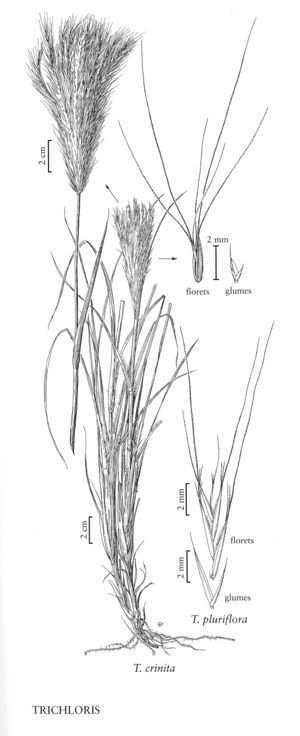| Taxon | Illustrator ⠉ | |
|---|---|---|
 | Trichloris crinita Trichloris pluriflora | Hana Pazdírková Linda A. Vorobik Hana Pazdírková Linda A. Vorobik |
Plants perennial; cespitose, sometimes stoloniferous. Culms to 150 cm, herbaceous, solid, glabrous. Sheaths open, rounded; ligules membranous, ciliate, cilia longer than the membranous base, conspicuous tufts of stiff hairs present on either side of the ligules; blades linear, flat or folded. Inflorescences terminal, panicles of non-disarticulating spikelike branches, exceeding the leaves; branches in 1 or more whorl (s), spikelets in 2 rows on the abaxial side of the branches, axes terminating in a functional spikelet. Spikelets laterally compressed, with 2-5 florets, lowest 1-2 florets bisexual, distal 1-3 florets progressively reduced and sterile; disarticulation above the glumes, all the florets falling as a unit. Glumes much shorter than the spikelets, membranous; lower glumes linear, acuminate; upper glumes lanceolate-ovate, awned; calluses bearded; lowest lemmas linear-lanceolate, 3-veined, veins prolonged into 3 awns; central awns 8-12 mm; lateral awns 0.5-12 mm; paleas 2-keeled, acute; distal floret (s) 1-3-awned; lodicules 2; anthers 2 or 3. Caryopses sulcate; embryos 1/2 as long as the caryopses; hila punctate, x = 10.
Distribution
N.Y., Ariz., N.Mex., Tex.
Discussion
Trichloris has two species, both of which are native to the Flora region. It differs from Chloris in its 3-awned lemmas. Both species of Trichloris have a disjunct distribution, populations in North America being widely separated from those in South America.
Lower Taxa
Key
| 1 | Lowest lemma awns subequal, the central awns 8-12 mm long, equaling or slightly longer than the lateral awns | Trichloris crinita |
| 1 | Lowest lemma awns unequal, the central awns 8-12 mm long, the lateral awns 0.5-1.5 mm long | Trichloris pluriflora |
"decumbent" is not a number."prolonged" is not a number.